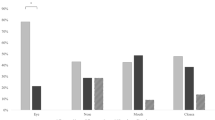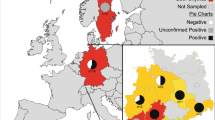Abstract
Pathogenic diseases may threaten the viability of wild animal populations, especially when already vulnerable. The mitigation of risks associated with pathogenic infections in populations is an important factor in conservation strategies. Koalas are of conservation concern across the north of their range and are affected by two main pathogens; Chlamydia pecorum and the koala retrovirus (KoRV). This study tested whether DNA from C. pecorum and KoRV could be detected in genetic material isolated from koala scats. Detection of C. pecorum in scat isolated DNA samples was compared with results obtained from urogenital swabs collected from the same individuals as part of an independent study. The ability to detect KoRV in scats from both northern and southern regions of the koala’s range was also assessed. There was a high level of concordance (5/6) between the detection of C. pecorum in DNA isolated from scats and urogenital swabs from the same individual. In positive samples, C. pecorum ompA genotypes were identical between DNA from scats and urogenital swabs in two out of three cases. In samples from the south of the koala’s range, KoRV copy number was higher in DNA isolated from scats compared to DNA isolated from ear tissue, potentially indicating the detection of horizontally acquired infections. Our results demonstrate the ability to detect C. pecorum and KoRV in DNA isolated from koala scats. This method will be useful for studying the prevalence, transmission and impact of these pathogens in wild populations which may subsequently inform conservation management strategies.




Similar content being viewed by others
References
Allen C (2015) Koala distribution, abundance, habitat and Chlamydia prevalence studies in the Strzelecki Ranges. NSW Office of Environment and Heritage, NSW
Archer M, Cork S, Hand S, Phillips S, Smith M (1987) Koala: Australia’s endearing marsupial. Reed Books Pty Ltd, Frenchs Forest
Bodetti TJ, Viggers K, Warren K, Swan R, Conaghty S, Sims C, Timms P (2003) Wide range of Chlamydiales types detected in native Australian mammals. Vet Microbiol 96:177–187
Burach F, Pospischil A, Hanger J, Loader J, Pillonel T, Greub G, Borel N (2014) Chlamydiaceae and Chlamydia-like organisms in the koala (Phascolarctos cinereus)—organ distribution and histopathological findings. Vet Microbiol 172:230–240
Cockram F, Jackson A (1981) Keratoconjunctivitis of the koala, Phascolarctos cinereus, caused by Chlamydia psittaci. J Wildl Dis 17:497–504
Czarnomska SD, Jędrzejewska B, Borowik T, Niedziałkowska M, Stronen AV, Nowak S, Mysłajek RW, Okarma H, Konopiński M, Pilot M (2013) Concordant mitochondrial and microsatellite DNA structuring between Polish lowland and Carpathian Mountain wolves. Conserv Genet 14:573–588
Department of the Environment (2015) Phascolarctos cinereus (combined populations of Qld, NSW and the ACT) in species profile and threats database. Commonwealth of Australia. http://www.environment.gov.au/sprat. Accessed 23 Dec 2015
Frankham R, Ballou JD, Briscoe DA (2012) Introduction to conservation genetics, 2nd edn. Cambridge University Press, New York
Guy AJ, Banks P (2012) A survey of current rehabilitation practices for native mammals in eastern Australia. Aust Mammal 34:108–118. doi:10.1071/AM10046
Hanger JJ, Bromham LD, McKee JJ, O’Brien TM, Robinson WF (2000) The nucleotide sequence of koala (Phascolarctos cinereus) retrovirus: a novel type C endogenous virus related to Gibbon ape leukemia virus. J Virol 74:4264–4272
Houlden BA, Costello BH, Sharkey D, Fowler EV, Melzer A, Ellis W, Carrick F, Baverstock PR, Elphinstone MS (1999) Phylogeographic differentiation in the mitochondrial control region in the koala, Phascolarctos cinereus (Goldfuss 1817). Mol Ecol 8:999–1011. doi:10.1046/j.1365-294x.1999.00656.x
Jackson M, White N, Giffard P, Timms P (1999) Epizootiology of Chlamydia infections in two free-range koala populations. Vet Microbiol 65:255–264
Kawakami TG, Sun L, McDowell TS (1977) Infectious primate type-C virus shed by healthy gibbons. Nature 268:448–449
Kawakami TG, Sun L, McDowell TS (1978) Natural transmission of gibbon leukemia virus. J Natl Cancer Inst 61:1113–1115
Kollipara A, Polkinghorne A, Wan C, Kanyoka P, Hanger J, Loader J, Callaghan J, Bell A, Ellis W, Fitzgibbon S (2013) Genetic diversity of Chlamydia pecorum strains in wild koala locations across Australia and the implications for a recombinant C. pecorum major outer membrane protein based vaccine. Vet Microbiol 167:513–522
Legione AR, Patterson JL, Whiteley PL, Amery-Gale J, Lynch M, Haynes L, Gilkerson JR, Polkinghorne A, Devlin JM, Sansom FM (2016) Identification of unusual Chlamydia pecorum genotypes in Victorian koalas (Phascolarctos cinereus) and clinical variables associated with infection. J Med Microbiol 65:420–428
Leighton F (2002) Health risk assessment of the translocation of wild animals. Rev Sci Tech 21:187–216
Markey B, Wan C, Hanger J, Phillips C, Timms P (2007) Use of quantitative real-time PCR to monitor the shedding and treatment of chlamydiae in the koala (Phascolarctos cinereus). Vet Microbiol 120:334–342. doi:10.1016/j.vetmic.2006.11.022
Martin R, Handasyde K (1990a) Population dynamics of the koala (Phascolarctos cinereus) in southeastern Australia. In: Lee AK, Handasyde KA, Sanson GD (eds) Biology of the Koala. Surrey Beatty and Sons, Chipping Norton, pp 75–84
Martin R, Handasyde K (1990b) Translocations and the re-establishment of koala populations in Victoria (1944–1988): the implications for New South Wales. In: Lunney D, Urquhart CA, Reed P (eds) Koala summit: managing koalas in New South Wales. NSW National Parks and Wildlife Service, Hurtsville, NSW, pp 58–64
Mathews F, Moro D, Strachan R, Gelling M, Buller N (2006) Health surveillance in wildlife reintroductions. Biol Conserv 131:338–347. doi:10.1016/j.biocon.2006.04.011
Miyazawa T, Shojima T, Yoshikawa R, Ohata T (2011) Isolation of koala retroviruses from koalas in Japan. J Vet Med Sci 73:65–70
Mohamad KY, Roche SM, Myers G, Bavoil PM, Laroucau K, Magnino S, Laurent S, Rasschaert D, Rodolakis A (2008) Preliminary phylogenetic identification of virulent Chlamydophila pecorum strains. Infect Genet Evol 8:764–771. doi:10.1016/j.meegid.2008.06.009
Mohamad KY, Kaltenboeck B, Rahman KS, Magnino S, Sachse K, Rodolakis A (2014) Host adaptation of Chlamydia pecorum towards low virulence evident in co-evolution of the ompA, incA, and ORF663 loci. PLoS One 9:e103615. doi:10.1371/journal.pone.0103615
NCBI (2016) Standard nucleotide BLAST. National Center for Biotechnology Information, National Library of Medicine. www.ncbi.nlm.nih.gov/BLAST/. Accessed 20 Jan 2016
Obendorf DL, Handasyde KA (1990) Pathology of chlamydial infection in the reproductive tract of the female koala (Phascolarctos cinereus). In: Lee AK, Handasyde KA, Sanson GD (eds) Biology of the Koala. Surrey Beatty & Sons, Chipping Norton, pp 255–259
Pantchev A, Sting R, Bauerfeind R, Tyczka J, Sachse K (2010) Detection of all Chlamydophila and Chlamydia spp. of veterinary interest using species-specific real-time PCR assays. Comp Immunol Microbiol Infect Dis 33:473–484
Piggott M, Banks S, Taylor A (2006) Population structure of brush-tailed rock-wallaby (Petrogale penicillata) colonies inferred from analysis of faecal DNA. Mol Ecol 15:93–105
Poudel A, Elsasser TH, Rahman KS, Chowdhury EU, Kaltenboeck B (2012) Asymptomatic endemic Chlamydia pecorum infections reduce growth rates in calves by up to 48 percent. PLoS One 7:e44961. doi:10.1371/journal.pone.0044961
Reid S (2014) Fire, fauna and habitat: influences on appropriate release site selection for rehabilitated wildlife. Masters thesis, Monash University
Short J (2010) The characteristics and success of vertebrate translocations within Australia 2009. Australian Government Department of Agriculture, Fisheries and Forestry
Simmons G, Young P, Hanger J, Jones K, Clarke D, McKee J, Meers J (2012) Prevalence of koala retrovirus in geographically diverse populations in Australia. Aust Vet J 90:404–409
Simmons G, Clarke D, McKee J, Young P, Meers J (2014) Discovery of a novel retrovirus sequence in an Australian native rodent (Melomys burtoni): a putative link between gibbon ape leukemia virus and koala retrovirus. PLoS One 9:e106954
Smith KF, Acevedo-Whitehouse K, Pedersen AB (2009) The role of infectious diseases in biological conservation. Anim Conserv 12:1–12. doi:10.1111/j.1469-1795.2008.00228.x
Stenglein JL, Waits LP, Ausband DE, Zager P, Mack CM (2011) Estimating gray wolf pack size and family relationships using noninvasive genetic sampling at rendezvous sites. J Mammal 92:784–795
Storfer A, Murphy MA, Evans JS, Goldberg CS, Robinson S, Spear SF, Dezzani R, Delmelle E, Vierling L, Waits LP (2006) Putting the ‘landscape’ in landscape genetics. Heredity 98:128–142
Tarlinton R, Meers J, Hanger J, Young P (2005) Real-time reverse transcriptase PCR for the endogenous koala retrovirus reveals an association between plasma viral load and neoplastic disease in koalas. J Gen Virol 86:783–787
Tompkins DM, Carver S, Jones ME, Krkošek M, Skerratt LF (2015) Emerging infectious diseases of wildlife: a critical perspective. Trends Parasitol 31:149–159
Wan C, Loader J, Hanger J, Beagley K, Timms P, Polkinghorne A (2011) Using quantitative polymerase chain reaction to correlate Chlamydia pecorum infectious load with ocular, urinary and reproductive tract disease in the koala (Phascolarctos cinereus). Aust Vet J 89:409–412
Wedrowicz F, Karsa M, Mosse J, Hogan FE (2013) Reliable genotyping of the koala (Phascolarctos cinereus) using DNA isolated from a single faecal pellet. Mol Ecol Resour 13:634–641. doi:10.1111/1755-0998.12101
Xu W, Stadler CK, Gorman K, Jensen N, Kim D, Zheng H, Tang S, Switzer WM, Pye GW, Eiden MV (2013) An exogenous retrovirus isolated from koalas with malignant neoplasias in a US zoo. Proc Natl Acad Sci USA 110:11547–11552
Xu W, Gorman K, Santiago JC, Kluska K, Eiden MV (2015) Genetic diversity of koala retroviral envelopes. Viruses 7:1258–1270
Ye J, Coulouris G, Zaretskaya I, Cutcutache I, Rozen S, Madden TL (2012) Primer-BLAST: a tool to design target-specific primers for polymerase chain reaction. BMC Bioinform 13:1–11. doi:10.1186/1471-2105-13-134
Acknowledgments
Grand Ridge Plantations Pty. Ltd (HVP Plantations) and the Holsworth Wildlife Research Endowment-Equity Trustees Charitable Foundation are thanked for funding this study. Richard Appleton (HVP) and Chris Allen (NSW Office of Environment and Heritage) are thanked for their support and assistance with the collection of scat samples in the Strzelecki Ranges. David Phalen is thanked for supplying swab isolated DNA for sequencing and quantitative PCR. David Phalen, Damien Higgins and Andrea Casteriano from the Koala Health Hub at Sydney University are thanked for their assistance and for conducting independent analyses. We thank Colleen Wood and the Southern Ash Wildlife Shelter for supplying tissue samples. Cheyne Flanagan and the Port Macquarie Koala Hospital are thanked for the collection of scat samples. Ashley Reed and the Koala Conservation Centre are also thanked for access to and assistance with collecting scats. We also sincerely thank the two anonymous reviewers for their comments and suggestions for improving this manuscript.
Author information
Authors and Affiliations
Corresponding author
Ethics declarations
Conflict of interest
The authors declare that they have no conflict of interest.
Ethical approval
A research permit was obtained under provisions of the Wildlife Act 1975 and National Parks Acts 1975 from the Department of Sustainability and Environment (Permit No. 10004020). Research was also approved by the Monash University Biological Sciences Animal Ethics Committee (AEC No. GIPP/2011/03).
Electronic supplementary material
Below is the link to the electronic supplementary material.
Online resource 1
Standard curves and data for real time PCR assays (DOCX 79 kb)
Online resource 2
C. pecorum sequences (FASTA file) (TXT 8 kb)
Online resource 3
KoRV sequences (FASTA file) (TXT 5 kb)
Rights and permissions
About this article
Cite this article
Wedrowicz, F., Saxton, T., Mosse, J. et al. A non-invasive tool for assessing pathogen prevalence in koala (Phascolarctos cinereus) populations: detection of Chlamydia pecorum and koala retrovirus (KoRV) DNA in genetic material sourced from scats. Conservation Genet Resour 8, 511–521 (2016). https://doi.org/10.1007/s12686-016-0574-3
Received:
Accepted:
Published:
Issue Date:
DOI: https://doi.org/10.1007/s12686-016-0574-3




